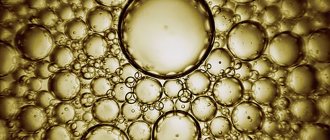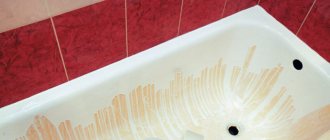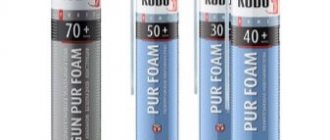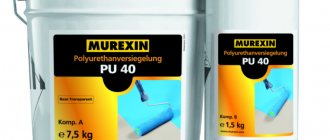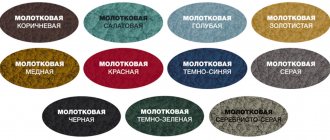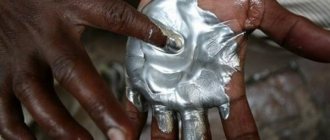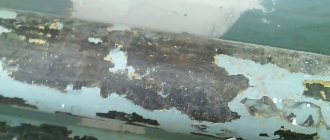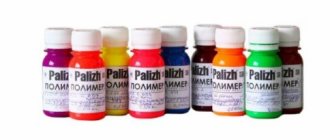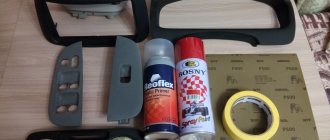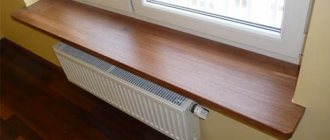Enamels: properties and scope
Enamel coatings refer to both liquid and paste-like materials, the base of which is diluted in solvents. Moreover, it should be noted that solvents can be either synthetic (White Spirit) or natural (turpentine).
By and large, almost any enamel is a pigmented varnish. Below are the most common types of finishing enamels:
- phenol-oil;
- alkyd;
- polyurethane;
- epoxy;
- acrylic, etc.
Despite such a variety of different enamels, alkyd enamel is mainly sold out on the Russian market. It is widely used not only for external, but also for internal work.
Enamel PF-115 is a bestseller. If you plan to protect metal surfaces outdoors from aggressive environmental influences, then PF-115 is the best option.
This is interesting: UV curing paints - application
Purpose and application
The properties of enamel and paint depend on the added film-forming substance, as well as what kind of pigment is present and how much of it.
The addition of pigment gives the following characteristics:
- improves protection against external factors;
- gives color;
- improves heat resistance;
- reduces the swelling coefficient;
- reflects ultraviolet light;
- increases anti-corrosion characteristics.
Metal powders are used as pigments. Also, for better wear resistance, organic additives are sometimes used: azo dyes, phthalecyanite, specks.
Important: Enamel compositions are used both for interior painting of premises and for treating facades. The material is characterized by good durability and long service life.
The main difference between paints and enamels
Do not forget that paint differs from enamel primarily in that the pigments themselves are dissolved in drying oil, and not in a solvent. At the same time, the paints still have high protective qualities.
However, they are used mostly indoors. The purpose of the premises is not very important. They can be both residential and industrial. For finishing facades, it is still better to use alkyd enamels.
There is also a classification for paints - adhesive, mineral, enamel, etc.
As far as one can see, the essence of enamel and paint is close, but there are still several differences. You need to choose a paint coating based on your own criteria (what is required from the coating - durability, color, etc.).
- Do you know how and what to paint indoor walls with?
- Recommendations for painting surfaces using a roller - https://postroyka.org/kak-krasit-valikom/
The video will describe all the negative aspects of alkyd paints. Especially recommended for viewing by non-professionals:
How to choose a laser level
How to make screw piles
Comparative characteristics of alkyd enamel
The scope of application has various restrictions. As a rule, enamel has an individual purpose. For example, PF-133 is only for metal and requires preliminary priming, enamel for radiators is no longer suitable for any work, and GF-230 is made only for mineral substrates indoors.
The paint is always applied in at least 2 layers, since it does not have good hiding power and the film formed is thinner than that of oil paints. In addition, the contact ability with various materials is worse. After drying, the coating is more elastic and less susceptible to cracking. The service life of enamels is approximately the same. The smell dissipates earlier, since the drying time is slightly shorter. Only white spirit is acceptable as a solvent.
Alkyd enamel also differs in external characteristics:
- There are different degrees of gloss available - from deep matte to super glossy.
- The colors are much more saturated and last longer.
- The possibility of coloring has more variations.
Unlike oil paints, alkyd enamels are produced in aerosol form. The degree of gloss is also provided for choice and there is a decent range of colors.
Basic information
Requirements
Requirements for the use of enamel and paints, regardless of their purpose:
Hiding ability is the ability to make the color of the material that will be processed invisible.- Adhesion – the adhesion of paint and varnish material to surfaces.
- Environmentally friendly.
- Wear resistance – resistance to high humidity, as well as mechanical damage.
First of all, paints are used to impart a specific color. Enamel is a similar paint and varnish material, but it will include the addition of a varnish agent. It turns out that the difference between paint and enamel lies in the composition. The choice will depend on the application.
Purpose and application
The properties of paints and enamels will depend on the substance added to form the film, as well as what exactly the pigment is and how much it has. Adding pigment gives the following characteristics:
- Adds color.
- Improves protection against external factors.
- Reduces swelling coefficient.
- Improves thermal stability.
- Reflects ultraviolet rays.
- Enhances anti-corrosion characteristics.
Metal powders are used as pigments. For an ideal indicator, wear-resistant additives of the organic type are azo dyes, speckles and phthalecyanite agents.
Please note that enamel compositions are used both for interior painting of premises and for facade treatment. The material is characterized by excellent stability and long service life.
Composition and characteristics
Enamel is a paint and varnish material that consists of additives, sand, metals, and also subject to heat treatment. The main difference between enamel-type paints is their increased degree of durability. Such compositions consist of pigments and various additives that will be converted into a protective layer; as fillers, they usually use a varnish composition or other substances with similar characteristics. The difference between oil paint and enamel is that the first is made from drying oil, where similar target types of fillers are added. Enamel mixtures based on drying oil are classified as paints and varnishes, and there is no specific difference between the materials. It is very difficult to determine the difference between enamel and oil paints.
In addition, some manufacturing companies try to create the illusion of a large selection of their products, and assign different names to paints and varnishes, taking into account the properties that should be emphasized. That is, in order to emphasize strength and shine, the manufacturer can call the coating enamel, although this is not at all true. If we consider the difference between oil paints and enamel, we can define it as follows - paint enamel with the addition of drying oil is called enamel, and with the use of linseed oil it is called paint.
Please note that in order to be able to determine how oil solutions differ from enamel-type mixtures, you should analyze the composition, which differs in the base and the additive used in the role of mixing.
Differences between materials and their compatibility
Terminology and composition
This is what real ceramic enamel looks like.
Enamel paints are a narrow segment of paint and varnish coatings that are highly durable and consist of a dispersion of pigments, fillers and various additives in a film-forming substance, the role of which is most often played by varnish, alkyd resin or other substance with similar physical and chemical properties.
Enamel paint is often applied to batteries.
Oil paints consist of natural, synthetic or combined drying oil, in which all the same pigments, fillers and auxiliary target additives are dispersed. Modern types of oil paints are most often mixed with glyphthalic, pentaphthalic and combined drying oils, as well as oxol drying oil.
Oil-phthalic coating is often called enamel.
Moreover, many manufacturers strive to create the appearance of a rich assortment and assign certain names to their products, based on the qualities that need to be emphasized. So, in order to highlight the strength or special shine of its product, the manufacturer calls it enamel, although this product has nothing to do with enamel as such. Of course, the price increases along with the growth of pathos in the product name.
Example of a polymer product.
The first enamel paints arose after pentaphthalic drying oil began to be modified with alkyd resins, as a result of which a more durable and durable coating appeared on the market. In order to somehow distinguish it from others and focus on increased quality, the material was called enamel, so that everyone would understand that the product is stronger and better than simple paintwork materials.
We can say this: material based on pentaphthalic drying oil is called enamel, and material based on boiled linseed oil (natural drying oil) is called paint. If you look at the labeling of cans, you will notice that often all enamel cans have the index PF (pentaphthalic), and all simple ones have the index MA (oil). There are also primers with the designation GF, which indicates glyphthalic drying oil in the composition.
Drying oil based materials.
Applying alkyd enamel to oil paint
Repainting window sashes is often done using the old base.
Important! It should be understood that the technology for applying paintwork materials involves complete cleaning of the base from old coatings. This is a condition for the most durable, long-lasting and beautiful protective layer that will fit well and serve for a long period of time. The success of the event depends by 60 percent or even more on the degree and quality of foundation preparation.
Now we will tell you how to apply enamel to paint with your own hands, and for convenience we have compiled instructions:
- We check the surface of the old coating for strength. If it peels off and comes away easily from the frame, it is best to remove it. If the coating is durable, then it should be washed from dirt and dust and sanded with coarse sandpaper;
We check the old finish for strength.
- After this, sweep away the dust and shavings, and wash the surface with water and soda. Don't forget to rinse the solution thoroughly with warm water. After this, wait for it to dry;
Add baking soda to the water and wash the windows.
- Open the jar, slightly dilute its contents with solvent or white spirit (1 - 2%) and mix thoroughly;
Lightly dilute the product with white spirit and mix.
- We apply the material in three thin layers, each new layer after the previous one has completely dried. It is better to apply the second and third layers thicker, without thinning. (See also the article Facade finishing - types.)
Carefully apply three layers of coating with a brush.
Important! Wear a respirator, gloves and safety glasses; alkyd coatings are toxic, especially during application and drying.
Peculiarities
The composition of any paint is always based on a certain amount of filler, binders, a mixture of pigments and solvents.
Pigments give the paint a certain shade and make the coating more elastic. Drying oils, synthetic polymers or aqueous dispersions act as a binder - these are so-called film formers, creating a dense film on the surface necessary to retain the internal components.
Solvents are water, oils, carbohydrates, alcohols, ethers, ketones, which reduce the viscosity of the paint. This has a beneficial effect on the application process.
Fillers are usually used to give the coating a matte effect, fire and heat resistance, UV resistance and abrasion.
Based on the number of the above elements, paint comes in the following types:
- glaze (transparent, translucent, opaque);
- alkyd;
- mineral;
- oil;
- adhesive;
- emulsion;
- liquid;
- pasty.
The product range includes interior and exterior paint formulations that can be used for priming and direct painting. You need to purchase a product based on the base on which it will be applied - it can be a plastic, wooden or metal surface. Depending on this, the method of application may change.
For example, to paint wood surfaces, you will need at least two layers of paint, of which the first will serve as a primer.
According to the production method, oil compositions are divided into two types:
The former can be used immediately after opening the package, but the latter require preliminary dilution with turpentine or drying oil.
Enamel paint (enamel) contains a film-forming component based on resin or varnish, as well as solvents, pigments, fillers and functional additives. Organic substances are used as solvents: turpentine, solvent or white spirit. The filler is usually microtalc, less often chalk.
Enamel paints can be divided into paste and liquid compositions according to their type. Regardless of the type, the paint forms a dense coating, which can be of a variety of colors, because the range of enamel palettes is quite diverse.
Water
Water-based paints are those mixtures whose base solvent is water. The drying process occurs due to the evaporation of water, as a result of which all film-forming substances come closer to each other and create a monolithic coating.
Kinds
Water-based paints come in very different compositions - it all depends on the filler substance:
- Silicate.
- Cement.
- Latex.
- Acrylic.
Peculiarities:
- Such solutions are used mainly for interior finishing work, since under the influence of various natural factors the coating quickly collapses.
- The drying speed of water-based paints is very high - one layer can set from 10 minutes to an hour or two (depending on the filling component).
- Aqueous solutions interact well with any finishing materials - they can be applied to rough finishes, wallpaper, wall panels, wood.
- They can be used in rooms with varying degrees of natural light, as they do not fade or turn yellow under the influence of ultraviolet radiation for up to 5-20 years.
- Since there are no organic solvents in the composition, water-based paints are usually odorless, safer and more environmentally friendly than any other types of compositions.
- Water-based coatings usually do not crumble, crack or peel if the layer thickness and application technology are followed.
- The finished finish based on water-based paint is “breathable”, so a comfortable microclimate is maintained in any room, and problems with “standing” air, fungi and mold are less likely to arise.
- The base color of water-based paints is white, but with the addition of color pigments you can get any shade of the buyer’s choice. This allows you to embody any artistic ideas when decorating your interior design.
This is interesting: How to properly dilute paint with hardener
General information
Paintwork materials perform both an aesthetic and protective function. Protect painted surfaces from various negative factors: ultraviolet radiation, high humidity, sudden temperature changes.
Requirements for the use of enamel and paints, regardless of their purpose:
- hiding power - the ability to make the color of the processed material invisible;
- adhesion – adhesion of paintwork materials to the surface;
- environmental friendliness;
- wear resistance – resistance to high humidity and mechanical damage.
Dyes are primarily used to impart a specific color. Enamel is a similar paint and varnish material, but includes the addition of varnish. That is, the difference between enamel and paint lies in the composition. The choice depends on the area of use.
Details
Consumption per square meter
Calculation of product consumption will depend on the conditions for applying the paint layer. However, the difference can be quite large. To process materials in one layer, approximately 0.1 to 0.14 kg of product per square meter is required. When calculating the average consumption rate, it is necessary to take into account the quality of the surface being treated, the viscosity of the paint and varnish, the location of the painting (street or apartment), and also the painting method (brush or spray gun).
The main differences between paints and enamels
To determine what the differences are between enamels and paints, you should compare these types of paints and varnishes. enamel compositions are used to treat surfaces, creating a thin glass film. In addition, they will be subject to processing at elevated temperatures. Paints will have lower protective properties, in contrast to the same enamels.
Important! The difference between paints and enamels is hardness and also elasticity. Enamel mixtures will have better performance properties. Enamel compositions do not lose their initial characteristics when exposed to external negative factors.
Advantages and disadvantages
Paint and varnish coatings, which are used in the decorative treatment of wall surfaces, are valued for a large number of advantages. Main advantages:
- Rapid polymerization will ensure high drying speed of coatings.
- Easy to process and safe, the materials have virtually no unpleasant odors, and the emulsion fumes are non-toxic.
- Wide range of colors, high coverage and thin-layer coatings.
- Excellent grip and versatility on all types of material.
- Beautiful appearance after decorative treatment.
- The tightness of the coating, which protects the wall surface from mold and corrosion processes, which will increase the service life of the material that will be processed.
It should be noted that rapid polymerization can only occur at positive temperatures.
The difference between oil paints and enamels
Paint and varnish oil mixtures are used for facade and interior work, for painting and priming various building materials. The compositions can be applied to wood walls as the first layer for further enamel coating. Taking into account the manufacture of paint and varnish products, two types can be distinguished:
- Thickly grated - before you start painting, the composition should be diluted with turpentine or drying oil.
- Liquid grated - the composition will be ready for use immediately after opening the jar.
Oil paints are not used as often as the final layer, because they will have some disadvantages:
- Long drying time.
- Insufficient coverage and poor abrasion resistance.
- The drying oil contained in the composition will, after a while, give a yellowish tint to the surface.
- A thick layer will not allow air to pass through, and this will lead to cracks on the surface.
- Toxicity of products made on the basis of synthetic drying oil.
The differences between enamel and paint are clear, but oil paints are popular due to their relative cheapness and versatility of use. The use of oil-type compounds on the surface is not subject to mechanical stress, and allows the coating to be used for a long time. The features of the paint and varnish coating will be determined by the area of application and the main purpose - the compositions can be used to treat almost all surfaces, and at the same time they will perform the function of protection. But such enamel indicators are much better.
Oil paint and enamel: similarities and differences
The production technology for these types of paints is similar: binder base and pigment . The similarity between enamel and oil paint is due to their scope and purpose: they are applied to almost all surfaces and perform a protective function. However, the protective properties of enamels are higher; they are more resistant to sunlight, temperature changes, and precipitation.
The main difference between oil paint and enamels is their composition. Since the base of enamels is varnish , such paint has a sharper odor in contrast to oil paints, which are based on drying oil .
During long-term storage, the pigment substances of oil paint settle, forming a dense layer at the bottom of the container, so before use it is necessary to thoroughly stir the drying oil and the settled pigment until a homogeneous mass is obtained. It is not recommended to store oil paint after opening the can; the settled pigment hardens and the paint becomes unusable. Enamel can become thick during long-term storage; before use, it is enough to dilute it with a solvent.
Repair and constructionComment
Minuses
Application of this composition in very humid rooms can lead to the appearance of whitish stains on surfaces, as well as various stains. This can be explained by the fact that the evaporation of acetone included in the paint occurs extremely quickly, which cools the surface. To eliminate this harmful effect, you need to use a solvent that is not very volatile. Finishing work must not be carried out indoors with humidity levels greater than 70%.
Very serious disadvantages are toxicity and flammability. You can only work with such substances using respirators, in well-ventilated areas or outdoors.
If necessary, it is permissible to dilute the nitro paint with acetone or special licensed nitro solvents.
Types of enamel coatings
There are many varieties of enamel compositions. Only the most common ones are listed below:
- Nitrocellulose. They contain cellulose nitrate, pigmenting substances, additives, fillers and solvent. Most often used for painting metal, concrete and wood. Packaged in cans and aerosol cans. A characteristic feature is a pungent acetone smell. Without preparation in accordance with technological instructions, combination with other paints is unacceptable.
- Organosilicon. Such compositions can be applied to materials and surfaces of all types. The characteristic qualities of silicone enamel coatings include moisture resistance, increased strength and wear resistance. This type of paint and varnish materials can only be combined with dried acrylic coating.
- Pentaphthalic and glyphthalic. They belong to a subtype of oil paints and are made from combined and synthetic drying oils after modification with alkyds. This type of paintwork material is compatible with polyurethane-alkyd, acrylic and epoxy compounds.
- Acrylic. They are a latex-based aqueous dispersion. Acrylic enamels can only be combined with paints and varnishes that are water-based. However, it is also possible to combine with other types of paints, subject to appropriate preparation.
- Urethane and alkyd-urethane. They are characterized by very high strength and wear resistance. Such compositions can be applied to surfaces painted with oil, epoxy or pentaphthalic paints.
Enamel
The term “enamel” has several meanings, united by common features. In its original scientific meaning, this is the name given to a durable glassy layer that covers various surfaces and performs a protective function. For example, tooth enamel or glaze applied to metal and secured by firing. The manufacturing material is glass powder, which melts when fired and forms a fairly durable coating.
In another sense, this term denotes a special type of paint that has a fairly thick consistency and gives an even, durable and glossy finish. These types of paints are produced on the basis of high quality varnish, containing drying oil and zinc oxides.
Their similarity to ceramic enamel is due to the fact that the painted surface in appearance resembles ceramic glaze. This type of paint has high protective properties, is resistant to abrasion and weathering. It can be applied after priming to almost any surface, including polyurethane foam and glue-sealant. There are several main types of enamels:
- Acrylic (they are used to paint furniture, floors, walls, windows, indoor doors, since they dry quickly, are non-toxic and safe in case of fires).
- Alkyd (best used for outdoor work, can be applied to wood and metal, not recommended for painting floors, takes a long time to dry and has a pungent odor that is toxic and lasts throughout the drying period and for some time after, so it requires ventilation even after complete drying).
- Nitroenamel (this type of paint is easily recognized by the smell of acetone, it is distinguished by the rapid drying process of the painted surface - within an hour, it cannot be applied to surfaces painted with oil paint - the old layer peels off, it is fire hazardous).
What else should you know?
- All enamels have higher protective properties than oil and water-based paints.
- If a question arises regarding the compatibility of acrylic and alkyd enamel, then there is such a nuance: two-component compositions cannot be applied to one-component ones, but vice versa, they can. In the first case, the destruction process will be irreversible, in the second, the finished coating will be strengthened. If, for example, acrylic or alkyd aerosol paint for ceramics is used, then it is often a one-component composition. A composition based on another substance can be applied on top of such a coating.
- An important nuance to remember when changing interior design: nitro enamel cannot be applied over an oil paint coating.
- Any solutions, especially oil paints, must be thoroughly mixed before use. And if the pigments in the oil solution settle tightly and stick to the bottom of the container, then such a mixture is no longer suitable for use.
- If the enamel has been stored for too long, it can be brought to the desired consistency with a suitable solvent before use. This will not reduce the quality characteristics.
- It is important to store water-based paints under the conditions prescribed by the manufacturer, since if these solutions freeze, they cannot be used further for their intended purpose.
When deciding which paint is best to buy for specific purposes, do not be afraid to consult with specialists. You will always be provided with such qualified assistance in the “Na, Stroy!” store if you need to buy paint or enamel in Blagoveshchensk. Here you will definitely like the range of products from reliable manufacturers, and the cost of various types of finishing materials!
How is enamel different from paint?
Very often, when purchasing paint and varnish materials, you can come across the names - enamel or paint. How are they different?
Vapor permeability
Enamels and paints create films of different types: alkyd and oil-based coatings, dull, impervious to steam. And water-dispersed coatings create a breathable coating. This parameter separates the use of enamels and paints: - mineral surfaces require vapor permeability (fine-porous materials tend to equalize their humidity with the environment), otherwise condensation will collect on the side of the coating adjacent to the base and the coating will begin to peel off. This is exactly what happens with the walls in the entrances, which are almost always covered with enamel. — metal surfaces require insulation from external influences; the less moisture and air penetrates the metal, the less it will oxidize (rust). In this case, it is more advisable to use enamels. — wood can change its geometric dimensions up to 8% throughout the year. those. Elasticity is also an important parameter. Enamels do not have elasticity and will begin to crack on wood, but the coatings created by enamel are mechanically stronger and harder. Water-dispersion paints are more elastic and less durable.
Types of enamel compositions
Nowadays, many different types of enamel coatings are made. Here is a list of the most common enamels:
- nitrocellulose. They consist of cellulose nitrate, fillers, solvents, special additives and pigmenting components. They are typically used for painting wood, concrete and metal surfaces. Available in liquid form, as well as in cans and aerosol form. Nitrocellulose enamel has a pungent odor of acetone. Most of these mixtures cannot be mixed with other paint products;
- organosilicon. They can be used to treat all types of surfaces. This enamel is characterized by high moisture resistance, wear resistance, and excellent strength. These paint and varnish products are combined with dried acrylic compounds;
- glyphthalic and pentaphthalic. These oil-based paints and varnishes are made from different types of drying oil, which is modified with alkyd substances. These mixtures are most often combined with epoxy, alkyd enamel paint, as well as acrylic products;
- alkyd-urethane and urethane. They have one of the highest levels of strength and wear resistance. They can be used to treat surfaces that already have a layer of pentaphthalic, epoxy or oil paint mixture;
- acrylic. These are water-dispersed compositions based on latex. Acrylic enamels are perfectly compatible with water-based paints and varnishes. They can also be combined with other types of paintwork materials, only after special training.
The complete list of different types of enamels and other paint and varnish products is much larger. To view the full list of mixtures, you can read special tables that indicate the compatibility of materials, their names and properties. Important! You should never apply oil mixtures to nitro enamels, since nitrocellulose compositions immediately begin to curl after contact with solvents that are not part of their composition. After mixing these two types of paints and varnishes, the applied layer begins to swell and bubbles appear on it.
Paint is a water-based suspension
It's like a solid in a liquid. Water-dispersion, water-emulsion, water-acrylic paints are water-based. : Porcelain tiles for parquet - features of choice
Enamel is a solution based on organic solvents
Enamel is pigments in liquid or paste form. Their medium serves as a film-forming solution in an organic solvent. Alkyd resins or varnish are used as a component for film formation.
After complete drying, a dense film is formed on the product or structure. Attention! It is the amount and type of additives that make simple oil paints shine more than enamel paints. Enamel paints and varnishes have a strong, pungent odor. This is one of the main differences from water-based paints. A pungent odor is not typical for them. It may be completely absent.
The difference between the compositions
To understand which option is best to use for painting the surface, you need to compare enamel and regular paint. To begin with, it must be said that the first type is used for finishing surfaces, forming a kind of thin glass layer after application. In addition, the enamel is processed at high temperatures. As for oil- or water-based paints, they are used to impart color to a specific surface. Do not forget that drying oil is used to dissolve pigments. If you use enamel, then a solvent is used for this purpose. Paints have low protective properties when compared with enamels. The main advantage of enamels over oil-based compositions is that they are used not only for painting premises. Alkyd options are often used for finishing facades. They are characterized by good stability and durability. Certain surfaces should be given special attention after treatment with such compounds. When applying enamel, the coating becomes smooth and shiny. Paint treatment gives a slightly different result. After painting, the surface has a dull and matte appearance. The difference between enamel and paint is hardness and elasticity. The first option has higher performance characteristics. When exposed to weather conditions or temperature changes, paint can lose its original properties, which cannot be said about enamel. The difference between these finishing materials is that enamels are used to process certain objects . Paints are necessary for large surfaces. In addition, oil or other compositions will cost slightly less than enamels. Continuing the topic, watch a video about the differences between enamel, paint and varnish.
The difference between enamel and acrylic paint in composition and technical characteristics
The most common types of materials used in repairs are acrylic and alkyd, which are more advanced types of oil-based enamels.
Although they are often confused, they differ radically in composition:
- Alkyd. Compared to enamels, these paints dry faster and form a protective film on the surface. It contains polyhydric alcohols, for example, glycerin and orthophthalic acid;
- Acrylic. They are produced on the basis of plexiglass, with the addition of components that improve the properties of oil paints.
Acrylic revolution
Our painters first became acquainted with acrylic coatings in the early nineties, although in other countries acrylic had probably been used for 30 years at that time.
Let's try to figure out why acrylic is so revolutionary. First, let's take a look at the containers in which these paints and varnishes are sold.
Unlike the enamels discussed above, here we see in front of us not one, but two cans: in one there is a base, in the other there is a hardener.
The components of acrylic coatings, unlike melamine-alkyd ones, cannot be stored in one container, since they will immediately react. Therefore, these products are supplied in two packages, the contents of which are mixed immediately before use. These are two-component materials (2K).
Let's say we mixed the components and applied acrylic enamel or varnish. To understand how curing occurs, we need to take a closer look at each of the components.
The first component contains a solution of acrylic copolymer. This is a high-molecular substance, a product of co-polymerization of acrylic monomers - acrylic and methacrylic acids and their esters
It is important for us now to understand that this copolymer contains units with hydroxyl OH groups. Remembered
Now about the second component - the hardener. It contains a polyisocyanate containing isocyanate groups -N=C=O. These are highly reactive compounds; they easily react with hydroxyl groups OH. This process underlies the curing of acrylic materials: when the copolymer solution and the hardener are mixed, the hydroxyl and isocyanate groups react according to the following scheme:
From the diagram we see that as a result of the reaction, a urethane bond is formed (the structure to the right of the arrow). And due to the fact that the isocyanate groups have the form of three-rayed stars (conditionally), the polymer, again, turns out to be “spatially cross-linked”.
Isocyanate groups can be conventionally depicted as three-rayed stars
Thus, when the acrylic film cures, polyurethane is formed (therefore, such enamels are also called polyurethane or acrylic-urethane). It is polyurethane that provides the coating with those excellent visual and consumer properties for which acrylic materials are famous.
The described mechanism is the main difference between acrylic coatings and enamels of previous generations. We can say that now the curing of paintwork materials has become a controlled chemical reaction, thanks to which painters are no longer dependent on many random factors.
The most important advantage of this method in practice was a significant reduction in the time for complete curing of paintwork materials. Thus, at an air temperature of 20 ° C and normal humidity, all irreversible changes in the acrylic coating are completed in 16-18 hours, and within a few more days the paintwork acquires maximum hardness. At a temperature of 60 °C, the coating completely polymerizes in 40-60 minutes, after which the car will be completely ready for polishing.
Two-component acrylic-urethane enamels with a physical and chemical curing mechanism are a step forward from nitro paints and alkyds. These materials allow you to obtain better coating quality and simplify the technological cycle
The finished film of acrylic enamel has high hardness (close to the hardness of glass), lasting gloss, excellent elasticity and wear resistance. Acrylics are resistant to acids, alkalis and solvents, have excellent adhesion to a wide variety of surfaces, and withstand exposure to sunlight and precipitation.
The advent of acrylic paints and varnishes opened a new era in body repair, making it possible, even in garage conditions, to create a coating comparable in quality to the factory one. This is why everyone loves acrylic.
